Instagram Post 4/12/2020
(Click on any image to view it in high resolution.)
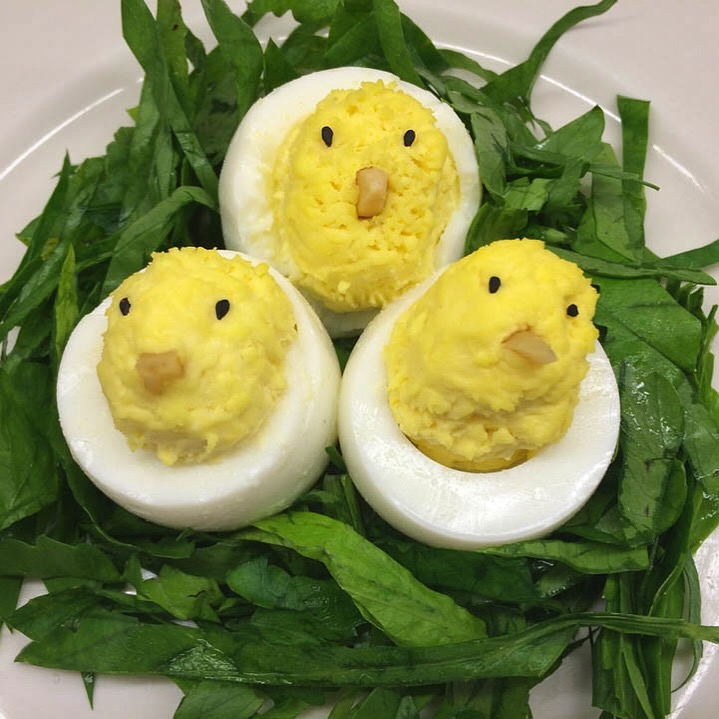
Since I love to put my own spin on holiday dishes, here’s how I do deviled eggs for Easter.
Happy Easter everybody!

👨🍳 Cooking in the Time of COVID 👨🍳
Alheira: another Portuguese sausage that followed me home from Seabra’s in Newark. In this case, I didn’t repurpose it into some wits’ end adaptation of authenticity but rather prepared it in the traditional fashion – not to mention that doing so required precious little time in the kitchen 😉.
(Click on any image to view it in high resolution.)
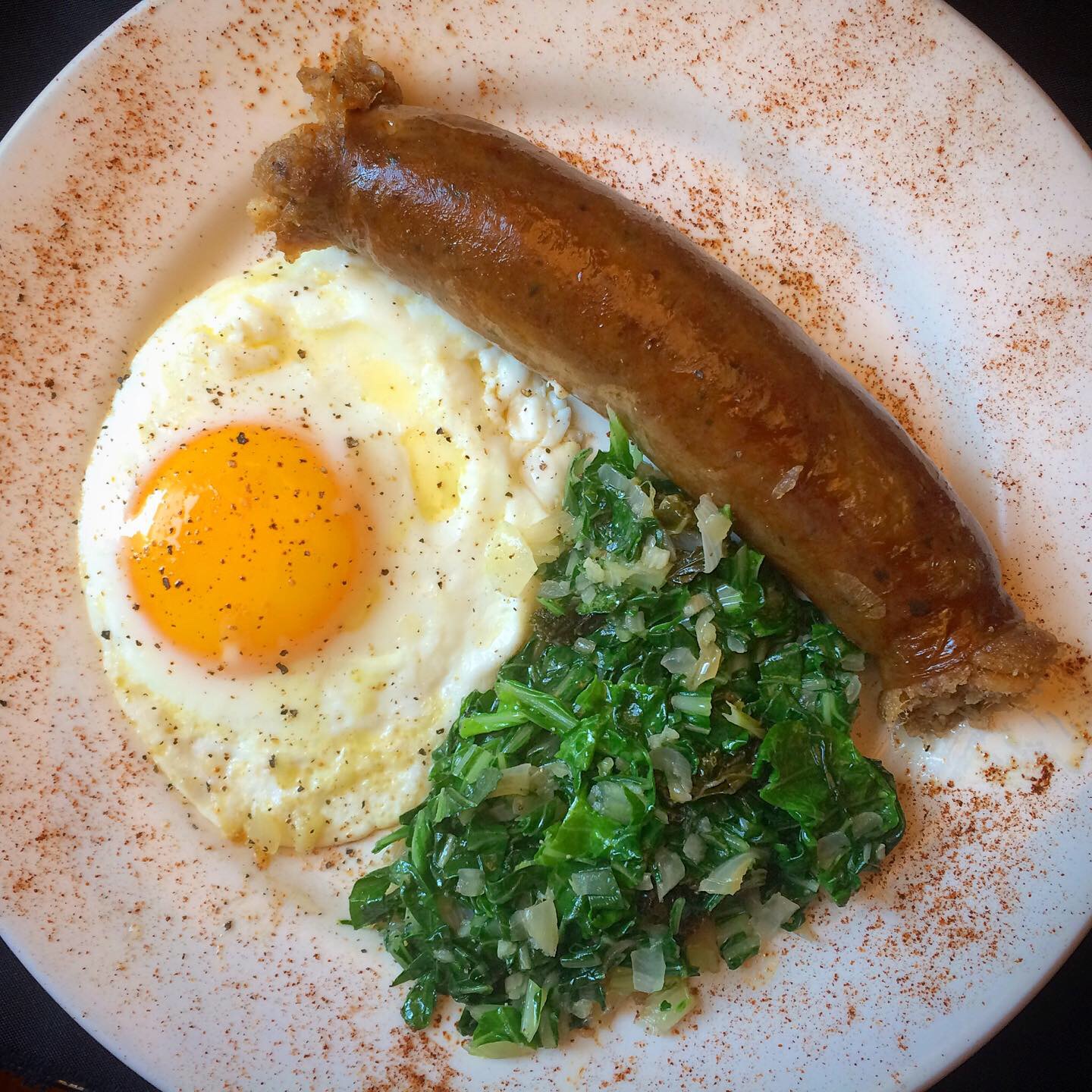
Originally, alheira was a bready, herby, garlic-heavy (alho means garlic in Portuguese) wily subterfuge reputedly cooked up by Portuguese Jews during the Inquisition; sometimes containing chicken or other meats, it looked the part when hanging in the smokehouse, but was porkless and therefore kosher, allaying any suspicion of non-Christian religious activities behind closed portas.
This one had no detectable meat other than in the form of fat – think Portuguese kishka – but brought a strong vinegar component to the plate. Often accompanied by a fried egg (a perfect foil to be sure) and sautéed greens, I tried to keep it real.
So that’s four sausages down, one more to go!
Stay safe, be well, and eat whatever it takes. ❤️
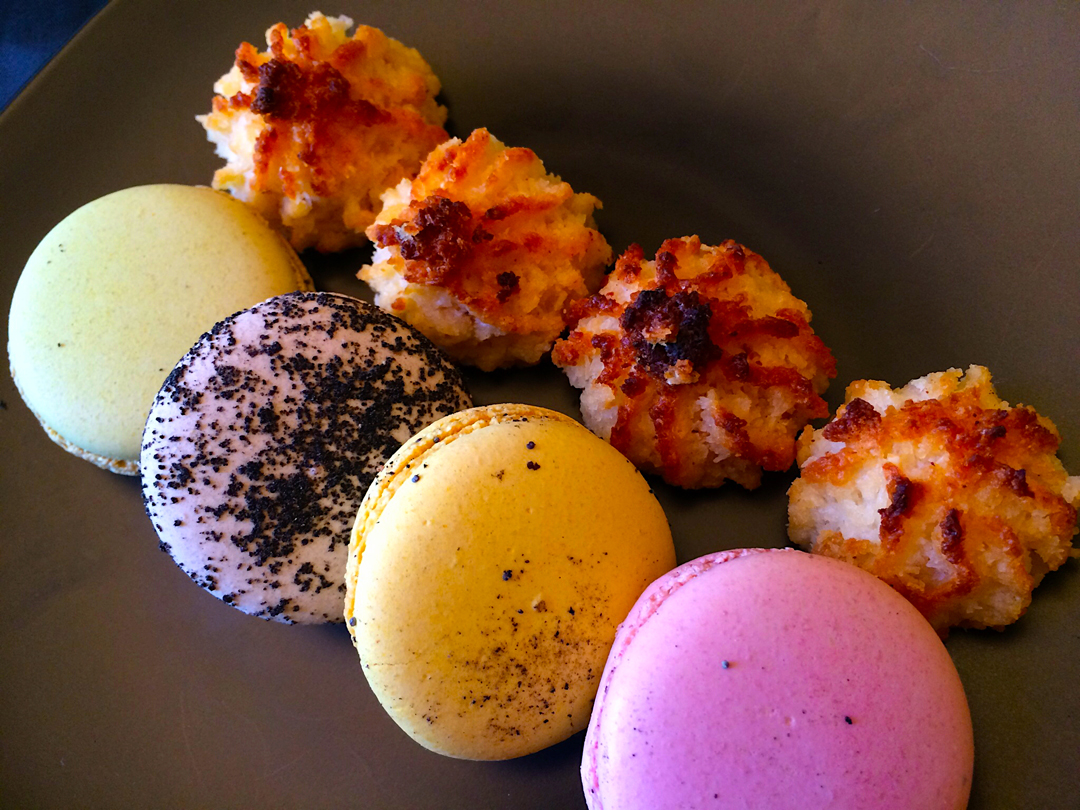 The following post is presented as a public service. 😉
The following post is presented as a public service. 😉
There seems to be some confusion regarding these two very dissimilar cookies with very similar names, but oh, what a difference an O makes. Let’s get the pronunciations out of the way first: macaroon rhymes with “black balloon” and if you honk the final syllable of macaron through your nez, you’ll nail the proper French pronunciation of that one.
Were the two cookies once a single biscuit that bifurcated due to some culinary tectonic shift? In search of the proto-macaroon, I consulted my copy of Larousse Gastronomique. There was a macaroon (their spelling) based on almond meal that has been made in a French monastery in Cormery since 791 (no, that’s not a typo) that’s not too different from one half of today’s macaron. I say half because the definition of a French macaron is that it comprises two almond flour cookies joined back to back by a sticky filling like jam or ganache. The seemingly infinite variety of flavors (more about that later) derives from the filling alone, and the coloring is just that: coloring. In my experience, they require the patience of a saint (or perhaps a monk) to produce competently.
Macaroons, in contrast, are quintessentially American; a mounded cookie consisting of shredded coconut, sugar, egg whites and sometimes sweetened condensed milk that in its rudimentary form is so uncomplicated as to make it a good candidate for a child’s first baking experience.
Etymologically, the word “macaron” makes a brief appearance in the writing of Rabelais in 1552. It stems from the Italian word “maccherone” meaning a “fine paste” (consider how the combined ingredients appear before baking) and yes, the word macaroni shares the same root (consider pasta/paste while you’re at it). Subsequently, it shows up in an English language recipe from 1611 that spells it “macaroon” and identifies the word as having been derived from the French “macaron”. So the words diverge centuries before the cookies do and the conflation conflagration begins.
The Renaissance version of the cookie itself was pretty well defined as a “small, round cookie, crunchy outside and soft inside, made with ground almonds, sugar and beaten egg whites” folded together, essentially what we think of as Italian amaretti. And so these macarons/macaroons prevailed for many years – there’s a recipe in Martha Washington’s Booke of Cookery – until just before the 20th century when two events occurred that altered the course of cookie history.
At that time, coconut palms were introduced to and cultivated in Florida and their fruit became the darling of the American kitchen. In 1871, Esther Levy published the first Jewish cookbook; it featured a recipe for macaroons in which grated coconut replaced the traditional almond flour. Because the dietary restrictions of the Jewish holiday Passover prohibit the consumption of leavened baked goods, coconut macaroons handily filled the dessert bill and they caught on.
A few years later, the Parisian bakery and tea salon, Ladurée, began selling almond flour macarons in pairs, flat sides back to back, with sweet fillings like ganache to hold them together. So at that juncture, we formally have two different cookies, each with its own proper name.
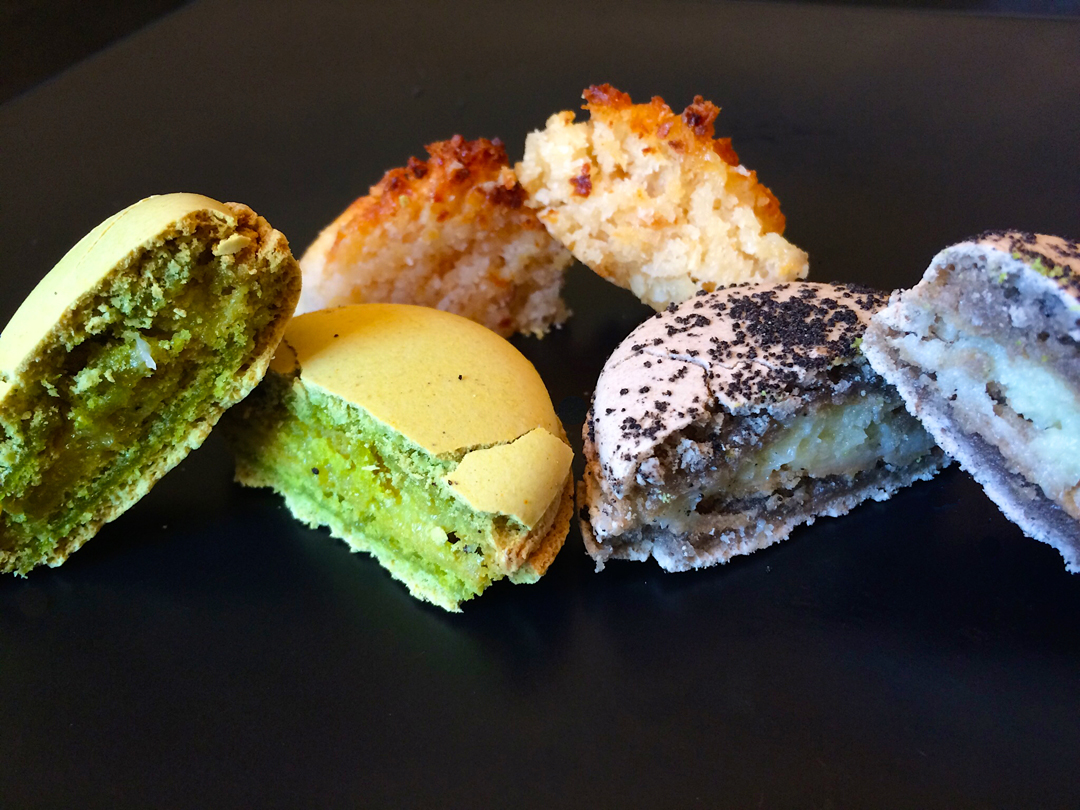
These days, French style macarons are quite trendy and can be found everywhere from fancy pâtisseries to bakery chains in Chinatown, although obviously the quality varies from venue to venue. This cutaway view shows the fillings inside a couple of macarons and the lack thereof in the standard issue macaroon. (The photo also serves to illustrate the way the cookie crumbles.)
Macarons come in several sizes but are always paired and share the classical puck-like shape. The sheer number of flavors to be found borders on the ridiculous and precludes any attempt at a comprehensive list, but you’ll see fruit flavors like cherry, banana, peach, pineapple, pomegranate, honeydew, coconut, papaya, passionfruit – actually pretty much every fruit you can name; what I’ll call “roasted bean” like coffee, latte, mocha, dark chocolate, milk chocolate, white chocolate; nuts like walnut, almond, pistachio; boozy specimens like Grand Marnier, Jack Daniels, Baileys Irish Cream, mojito; other dessert interlopers like crème brûlée, salted caramel, praline, Nutella, cotton candy, Oreo cookie (a cookie that’s designed to taste like another cookie?); Asian influences like pandan, durian, candied ginger, thai tea, red bean, mung bean, matcha tea, taro; floral/herbal flavors like lavender, mint, rose; and just plain brazen contenders like fois gras, wasabi, maple syrup & bacon, cheeseburger, bubblegum, Cheetos, and Vegemite. Mon dieu!
Then there are the double combinations like raspberry almond, blueberry cheesecake, lavender honey, white chocolate mint, strawberry kiwi, rhubarb cilantro and the like, not to mention triples like s’mores – you mathletes out there could calculate the permutations and combinations if only the flavor list weren’t infinitely long.
Not to be left out, popular brands of Passover macaroons including Manischewitz, Streit’s and Gefen have entered the fray but with somewhat less rebellious flavors like almond, chocolate chip hazelnut, red velvet, cookies & creme, pistachio orange, carrot cake, cappuccino, toffee crunch, chocolate mint, and purely coconut – again, a list that’s far from exhaustive.
I kind of like the fact that you can get almond macaroons and coconut macarons. Seems right somehow.
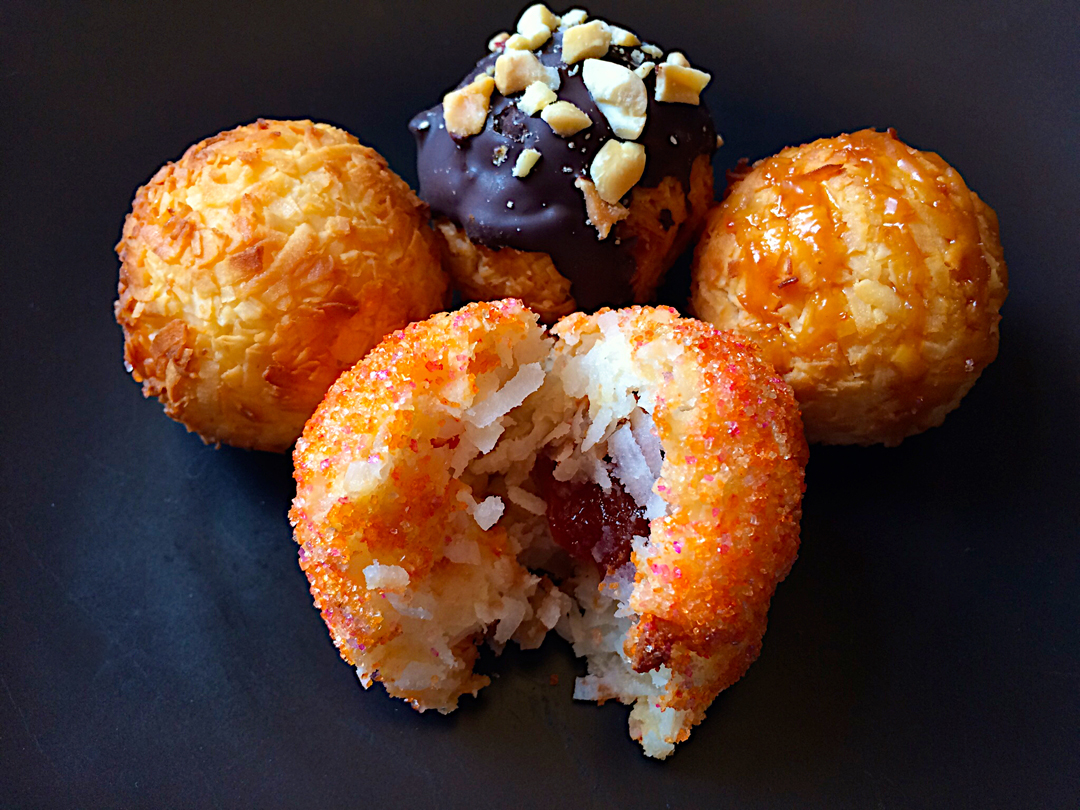
Beyond the popular brands of macaroons often sold in cans, I’m also seeing some serious bespoke examples at upscale bakeries. These second generation macaroons, if you will, turned up at the incredible 2018 World’s Fare in Queens and were crafted by Danny Macaroons: original coconut, peanut butter chocolate, salted caramel, and pineapple-guava filled.
Dedicated holidays cement the distinction: National Macaroon Day is celebrated on May 31; International Macaron Day appears to be tied to the first day of spring, around March 20. (There’s even a Chocolate Macaroon Day on June 3rd but it seems to embrace both macaroons and macarons.)
So armed with this fresh batch of information about the difference between macarons and macaroons, you can officially consider yourself one smart cookie. If you’re anything like me, you’re a fan of both!
(Note: Not to be confused with Emmanuel Macron, President of France. No relation.)
(Originally posted on April 20, 2019, in better times.)
(Click on any image to view it in high resolution.)
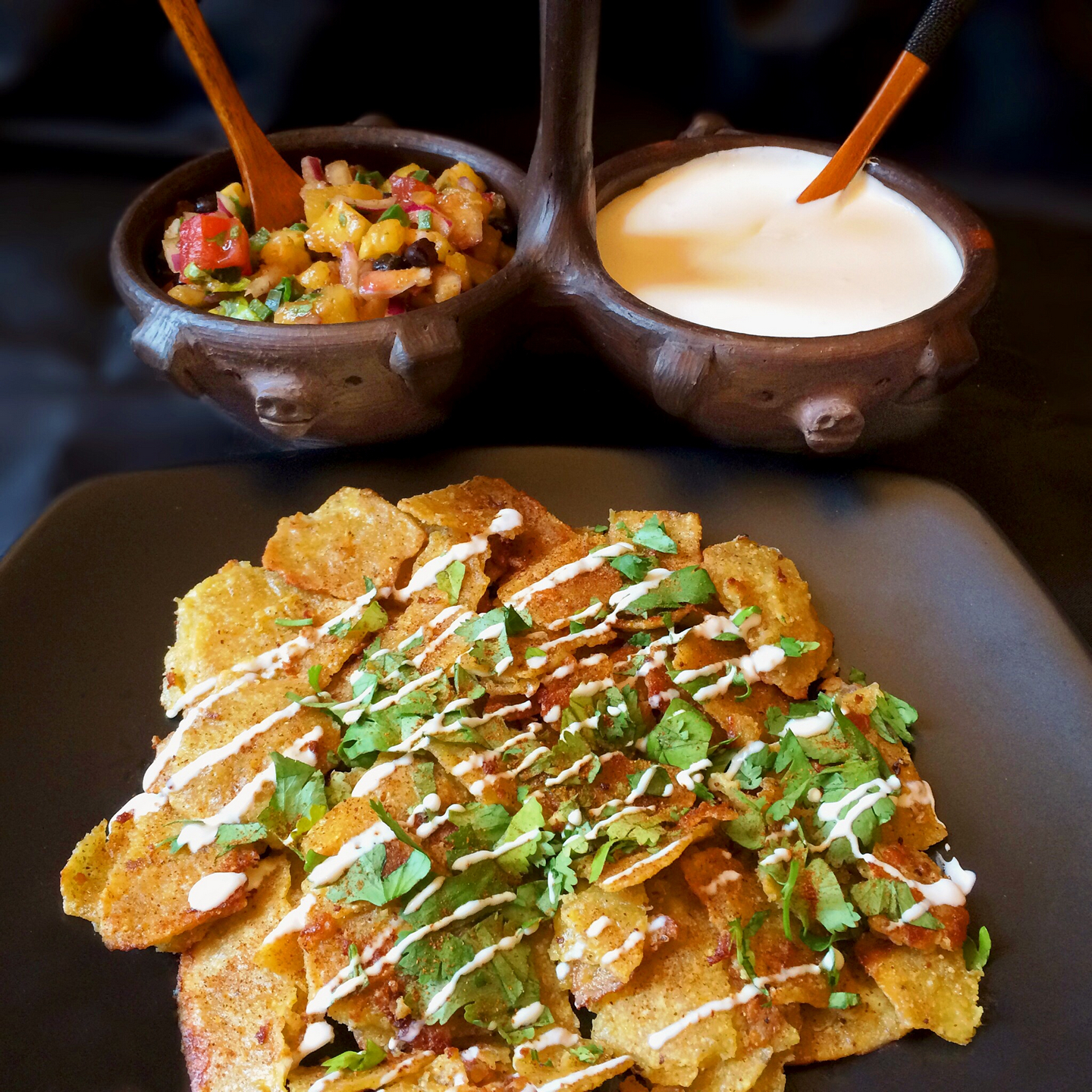
Previously on ethnojunkie.com, I did a springtime post that included a story about someone who dared me to come up with an ethnic fusion Passover menu. I wrote:
Well, far be it from me to dodge a culinary challenge! So although obviously inauthentic, but certainly fun and yummy, here’s to a Sazón Pesach!
Picante Gefilte Pescado
Masa Ball Posole
Brisket Mole
Poblano Potato Kugel
Maple Chipotle Carrot Tzimmes
Guacamole spiked with Horseradish
Charoset with Pepitas and TamarindoAnd, of course, the ever popular Manischewitz Sangria!
It was all in good fun, of course, but it got me thinking about actually creating a Jewish-Mexican fusion recipe. It isn’t strictly Kosher for Passover, but I thought the concept was worth a try. So here is my latest crack at cross cultural cooking: Masa Brei!
Now you might know that Matzo Brei (literally “fried matzo”) is a truly tasty dish consisting of matzos broken into pieces that are soaked briefly in warm milk (some folks use water), drained, soaked in beaten eggs until soft, then fried in copious quantities of butter. Typically served with sour cream and applesauce, it’s heimische cooking at its finest, Jewish soul food, and it’s easy to do.
So I thought it might be worth a try to swap out the matzos for tostadas, the milk for horchata, the sour cream for crema, and the applesauce for homemade pineapple-jalapeño salsa. A sprinkle of tajín, a scatter of chopped cilantro – and it actually worked!
Happy Passover!
!חג פסח שמח
👨🍳 Cooking in the Time of COVID 👨🍳
Months ago, when I last visited Newark’s Ironbound district, I paid a visit to Seabra’s flagship market at 260 Lafayette St; appropriately, it’s the size of a suburban supermarket and is the motherlode of all Portuguese and Brazilian food cravings. I bought too many varieties of Portuguese sausages (my standard MO when I can’t make a decision), did some snackin’, and stashed the rest in the freezer for another time.
(Click on any image to view it in high resolution.)
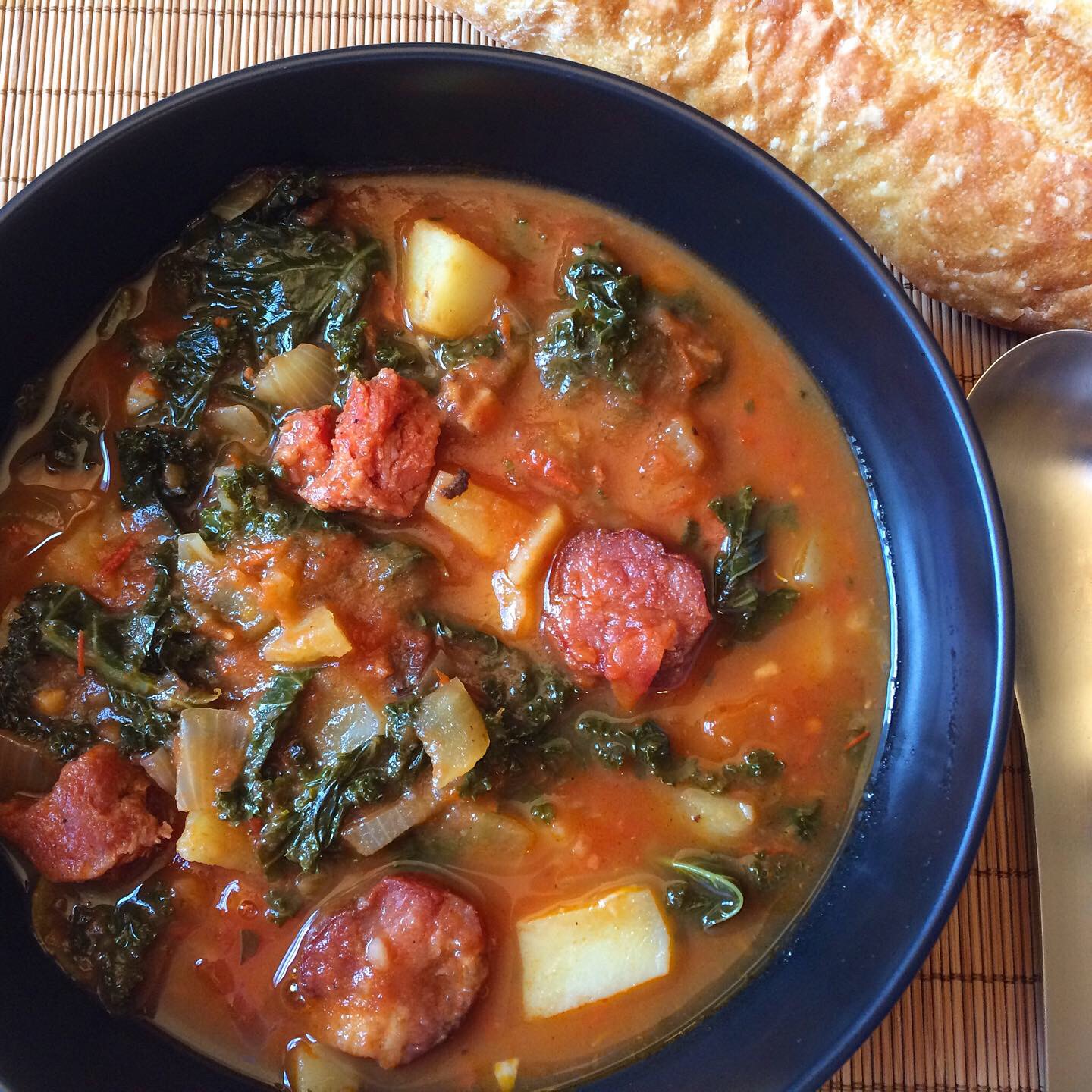
That time, obviously, has come.
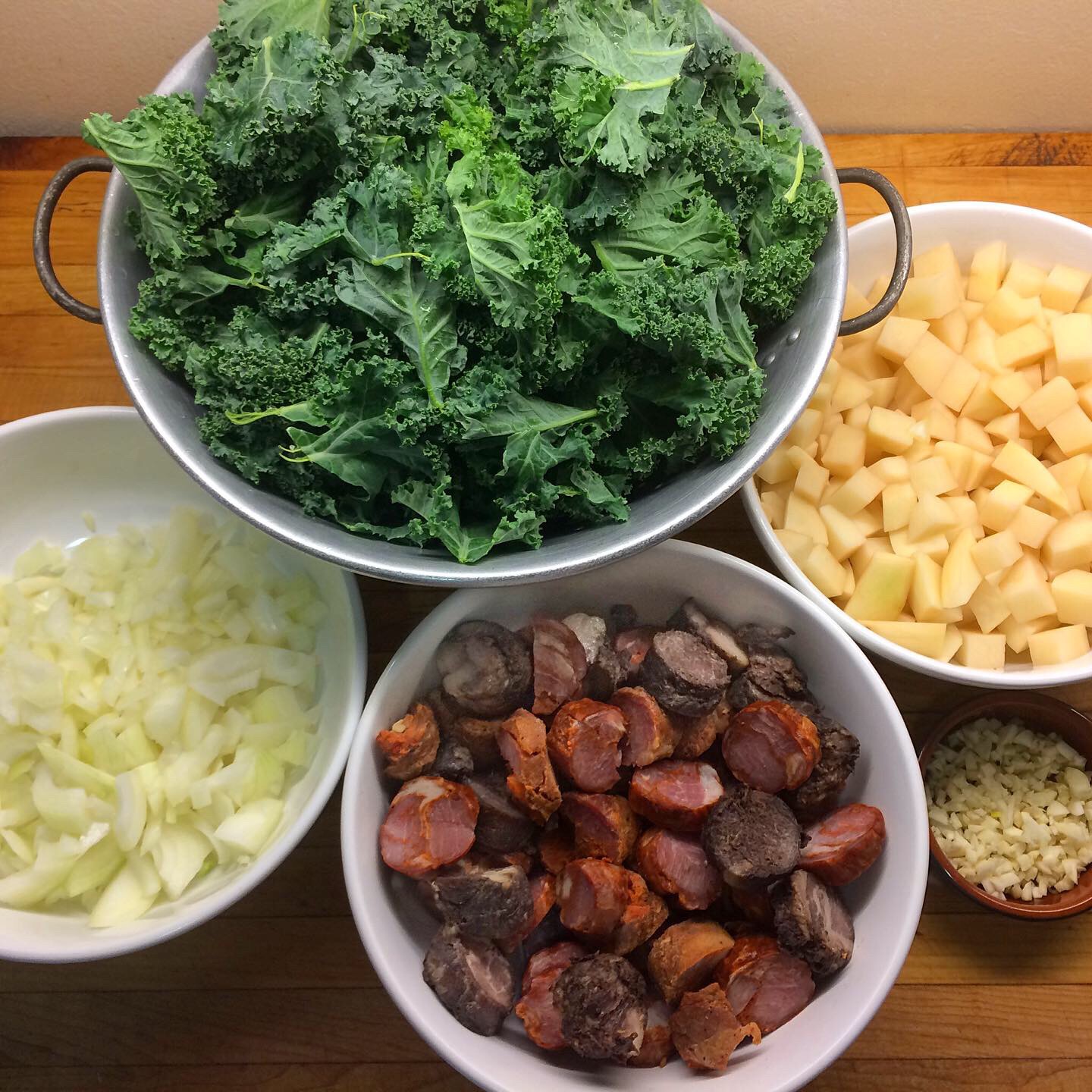
Therefore, with an eye towards preparing the iconic Portuguese kale and chouriço soup, kale and potatoes topped the list on my now highly sporadic local shopping trip; I had the other ingredients on hand (chicken broth, canned tomatoes, onions, garlic, herbs and spices). If you’re curious about the sausages, there’s smoky Transmontano and two kinds of Chouriço Caseiro (home style), a dry one and a darker, softer number, both made from pork and wine.
So now, instead of too many sausages in the freezer, I have too much soup. 😕 Wouldn’t it be great if that were the worst of our problems? (Or should I say the wurst? 😉)
Stay safe, be well, and eat whatever it takes. ❤️
(Click on any image to view it in high resolution.)
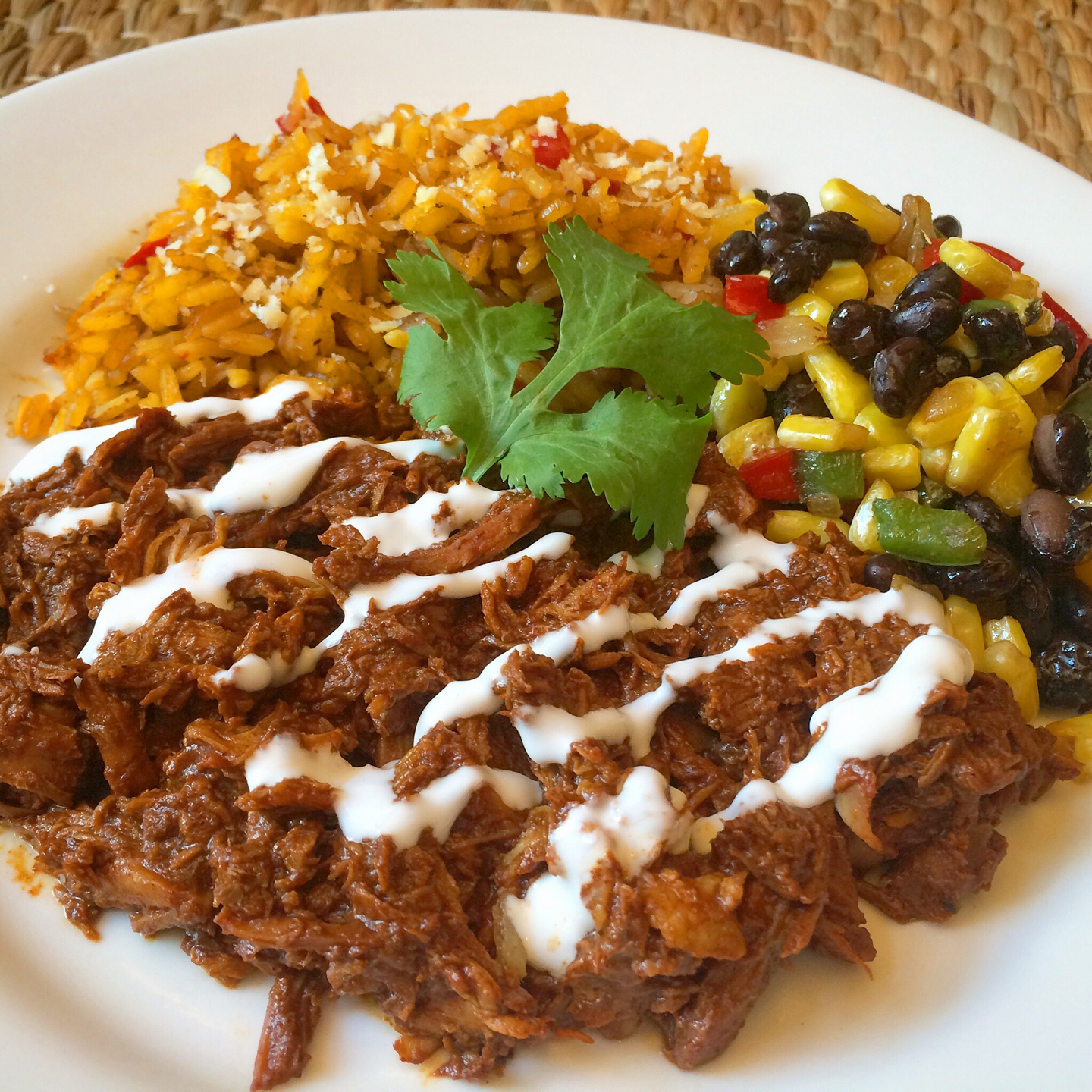
👨🍳 Cooking in the Time of COVID 👨🍳
Part of my COVID-19 culinary strategy is to shelter in place and minimize shopping trips by using leftovers augmented by whatever I have in the pantry in order to prepare a variety of diverse meals. I mean, how many days in a row can you eat chicken salad wraps before you get totally bored with them? (I maxed out at three.) And some of you know I have a pantry stocked with international ingredients and a spice rack to match at the ready, anticipating the chance to fulfill their destiny in whatever (hopefully) tasty dinner I might throw together for visiting friends.
Obviously, that’s not happening anytime soon.
So I’ve been cracking into my stash. Consequently, front and center: I shredded the last of the chicken and combined it with a packet of Mole Rojo Oaxaqueño; topped it with some crema I had in the fridge.
I always have rice on hand; I used chicken broth (made from chicken bouillon paste, so that’s chix flavor plus salt) along with onion, garlic, red bell pepper and achiote for color. I’d like to say that that’s freshly grated cotija cheese sprinkled on top, but not gonna lie: it’s Parmigiano Reggiano that I’ve always got hanging around.
On the side, the last of some black beans (you’ll see what I did with those in an upcoming post), corn, and some rescued JIT jalapeños with red pepper, onion, garlic and spices including Mexican oregano and Tajín.
I could have plated it better I guess, like scattering Tajín around the naked part of the plate, but I was too hungry after all that cooking! 😉
Stay safe, be well, and eat whatever it takes. ❤️
(Click on any image to view it in high resolution.)
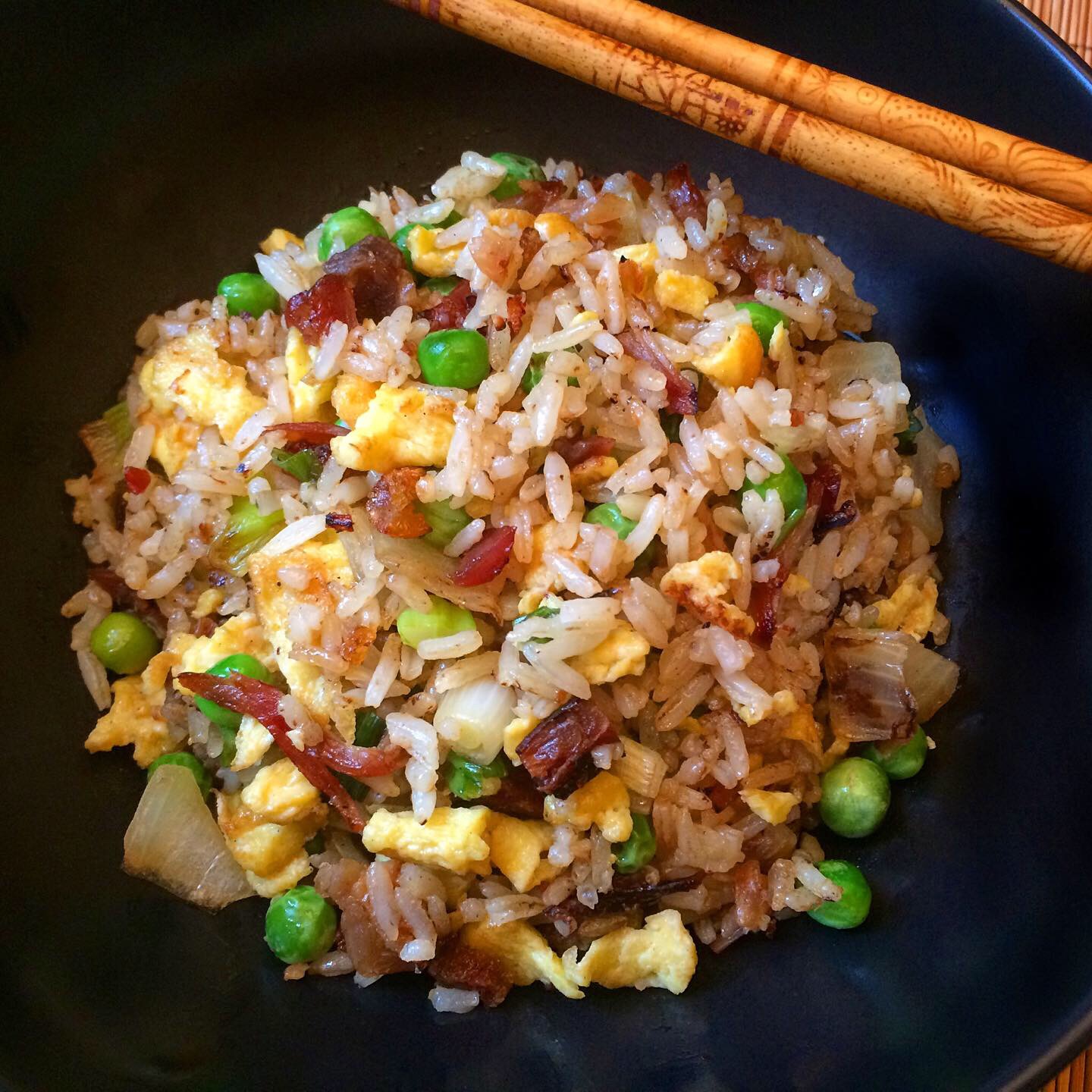
👨🍳 Cooking in the Time of COVID 👨🍳
So as I wrote recently, I laid in a supply of siu mei (燒味) – barbecue/roast meats like roast pork, roast pig, duck, spare ribs, etc. – from Great NY Noodletown, 28 Bowery in Manhattan’s Chinatown when I visited a few weeks ago and needless to say, I overdid it. I don’t usually get spareribs, but they looked tempting hanging in the window and I already had a metric ton of char siu in the freezer so I succumbed; I enjoyed a plateful and froze the rest with no specific future application in mind.
Shelter-in-place solitary home cooking becoming routine these days and not eager to spend a lot of time in the kitchen, I decided that I’d shave off the ribs’ meat and use it for fried rice since I already had some plain white rice left over from previous culinary hijinks and I had all the other ingredients on hand. If this isn’t comfort food, I don’t know what is.
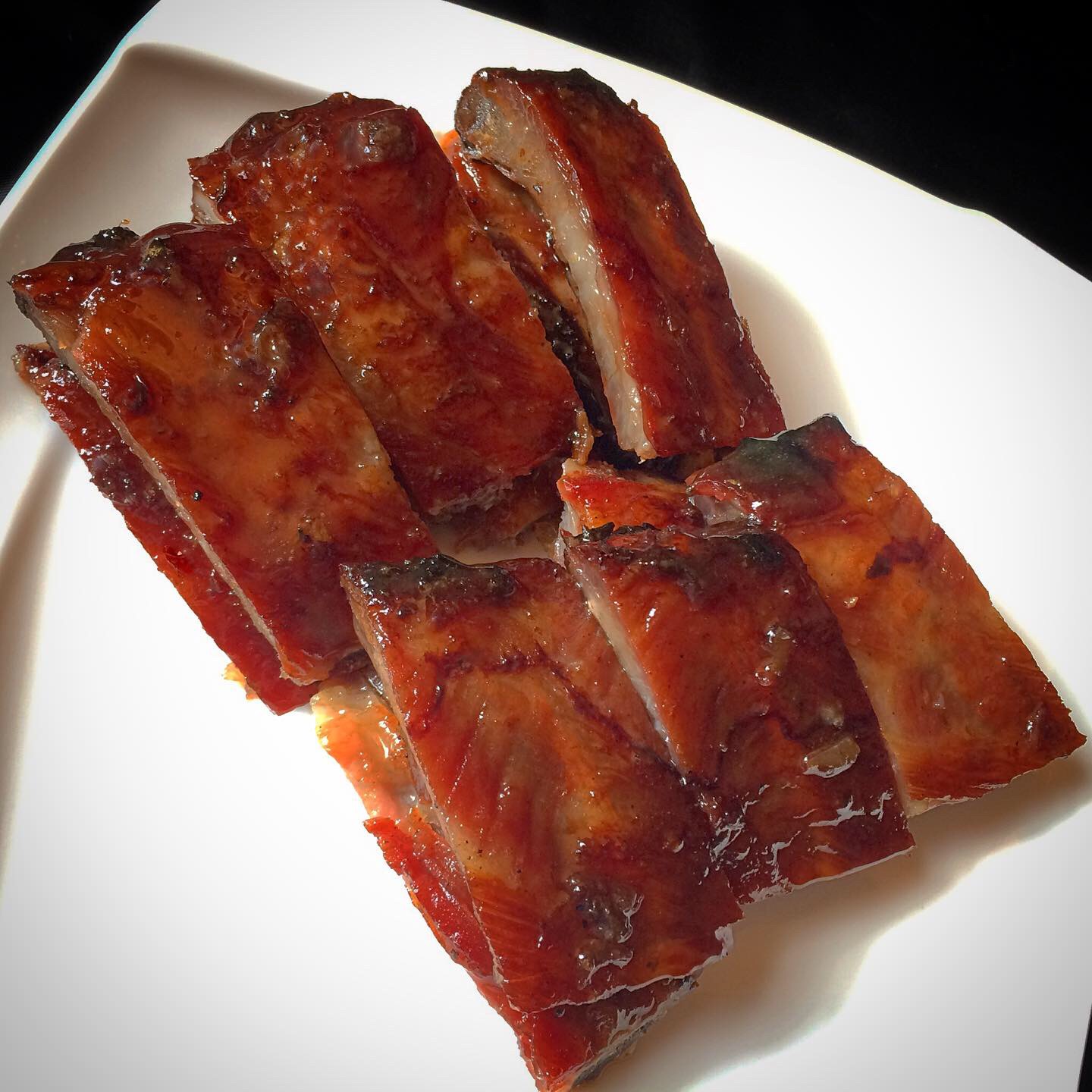
Some of the spare ribs from Day One.
Stay safe, be well, and eat whatever it takes. ❤️
I did a few posts recently about Mumbai street food in Floral Park Queens; the examples I tasted were okay but they didn’t blow me away. So I was more than curious about Bombay Kitchen, an extension of Rajbhog Sweets at 72-27 37th Ave in Jackson Heights, and I have to say I was pleasantly surprised.
(Click on any image to view it in high resolution.)
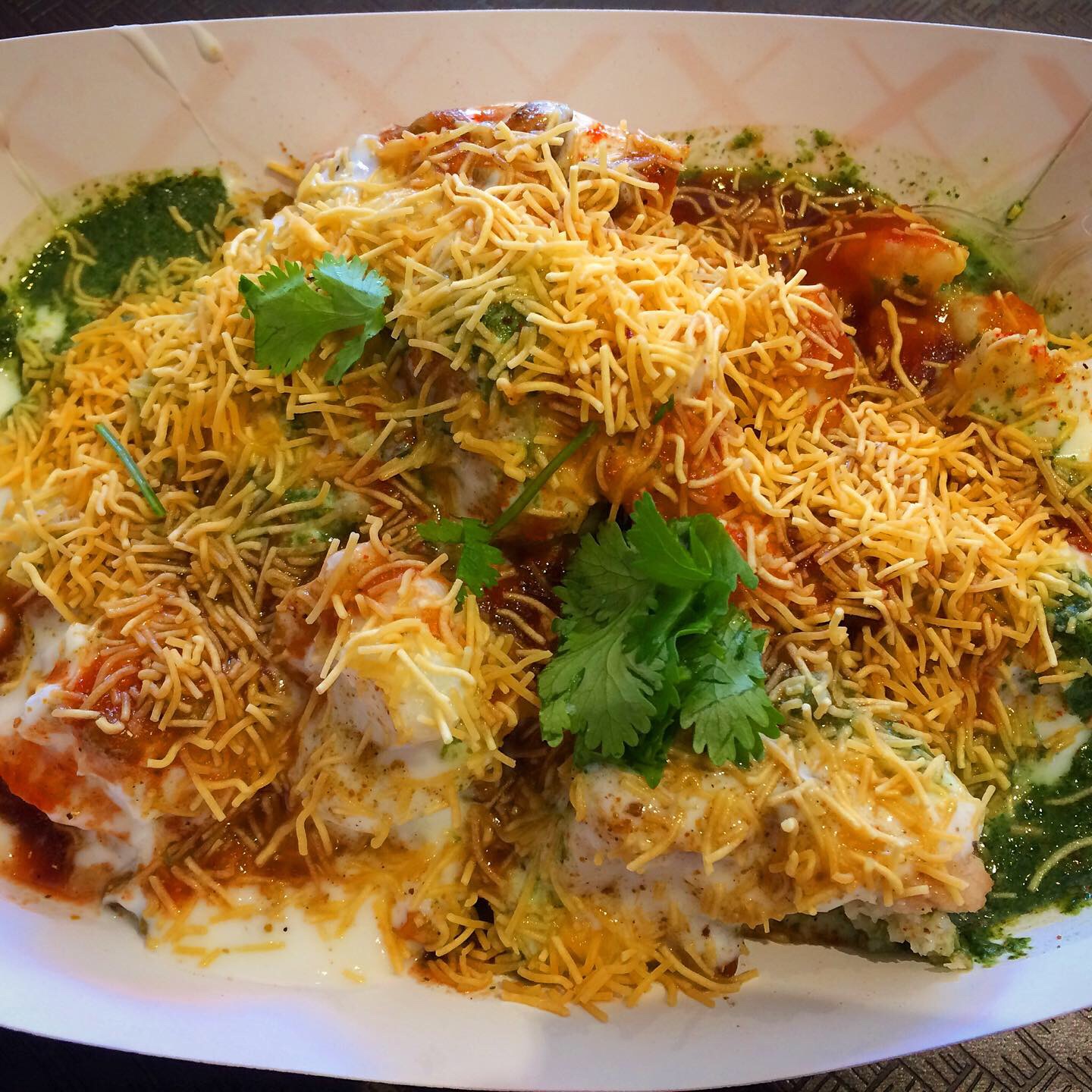
I like chaats in general – actually I like anything with a lot of stuff going on: probably increases the odds of finding at least one delicious mouthful. This is their Dahi Bhalla Chat, a linguistic and geographic variant on dahi vada, a sweet and spicy Indian snack with multiple variations but usually anchored with fried crispy bits, potatoes, chickpeas, onions, and cilantro and kept afloat with yogurt (dahi) and chutneys; a masala spice blend ties it all together. Sweet and savory, crunchy and yielding, creamy and tangy, it’s a delectable study in contrasts.
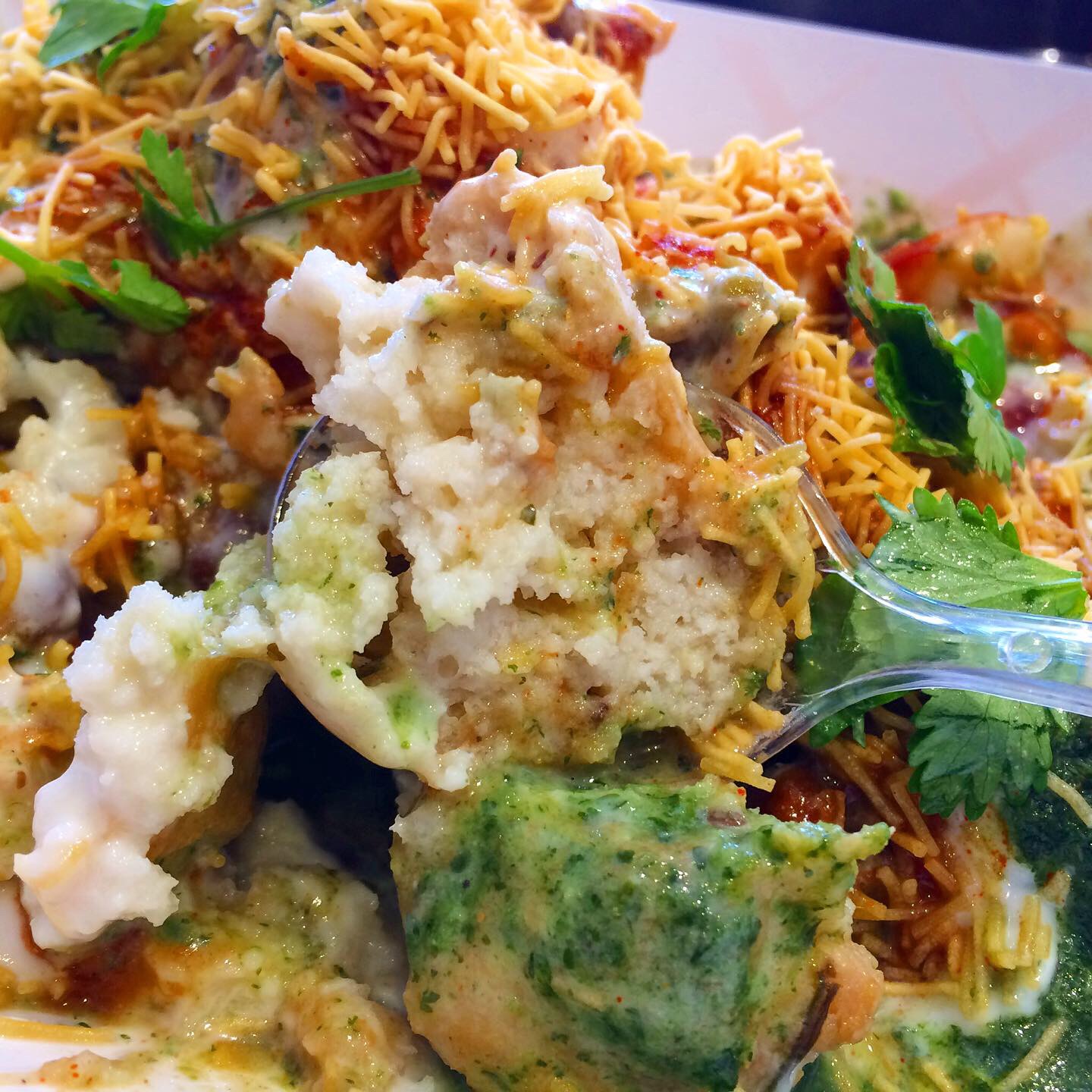
This instance was one of the best I’ve ever enjoyed because this bready, cakey, doughnutty, sweet, almost floral vada elevated it beyond its rivals. Excellent.
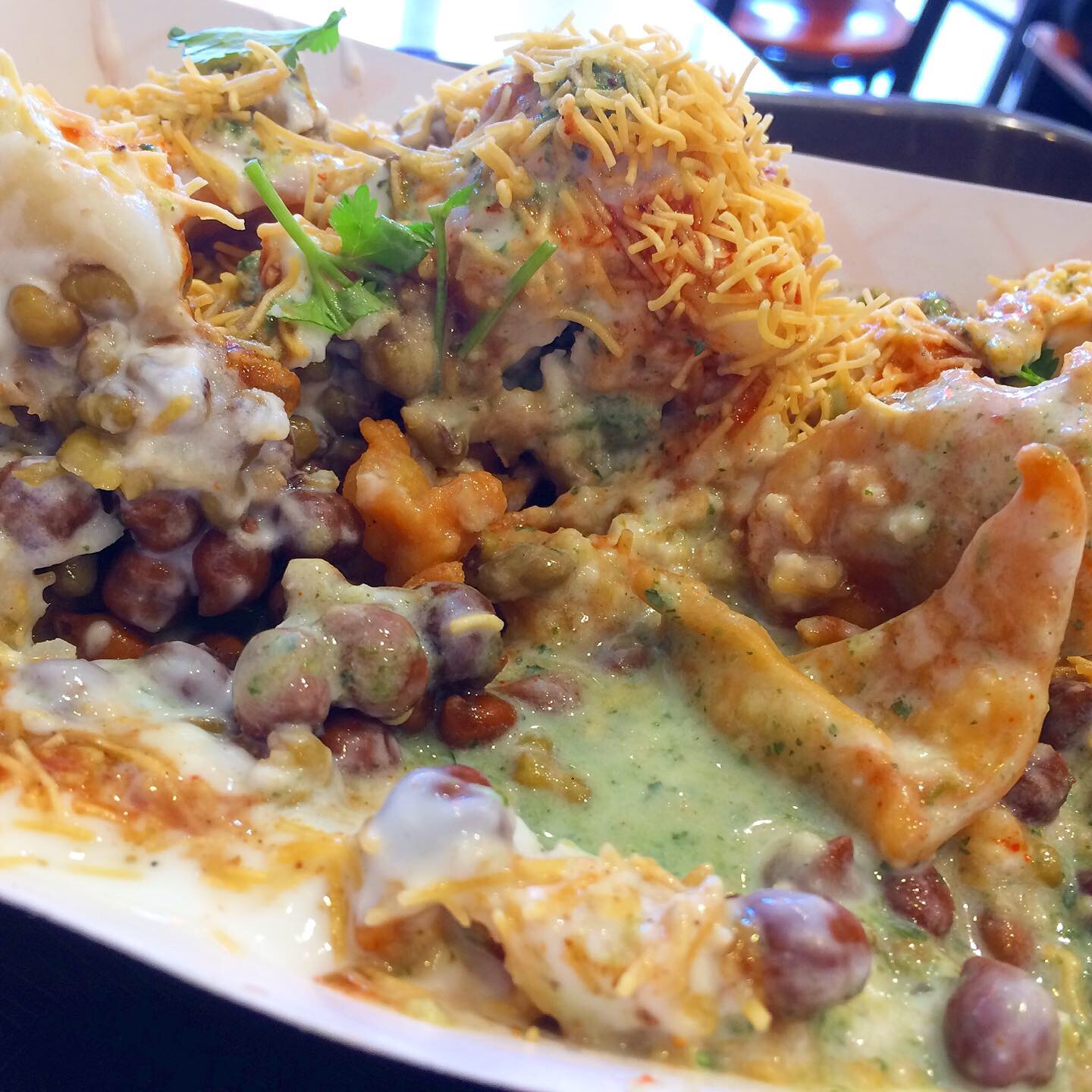
The inner workings.
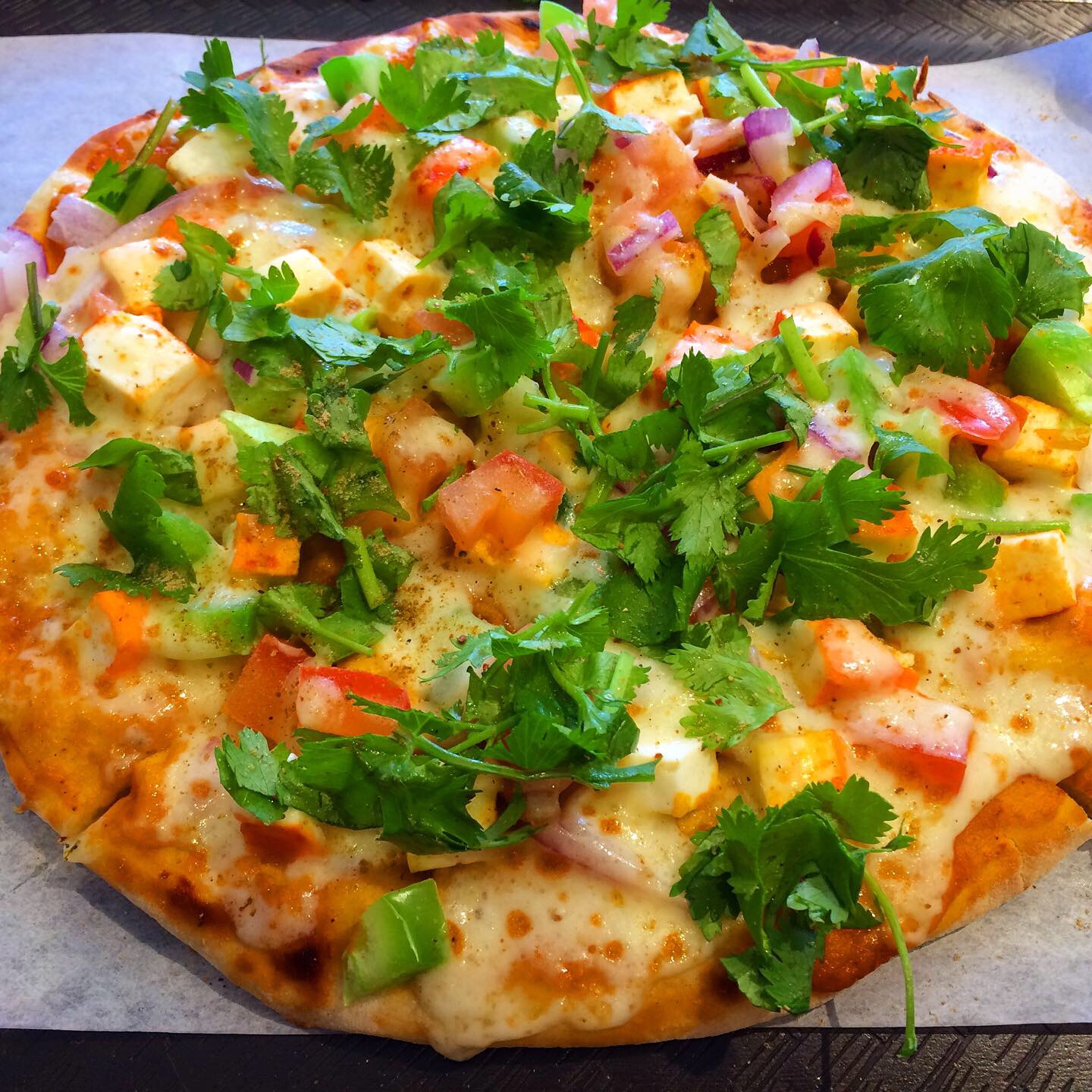
I guess it all depends on how you define pizza. Dough with stuff on top of it baked in a hot oven? I’d eat that. Everybody’d eat that. But I’d be hard pressed to call it pizza. Heck, I’m hard pressed to call Chicago deep-dish pizza pizza. (Don’t hate me, okay? I went to school in New Haven back in the day when men were men and pizza was ah-beets. But I digress.) This is my second foray into “Indian pizza”. This one from Bombay Kitchen was definitely tasty and better than my first experience in Floral Park.
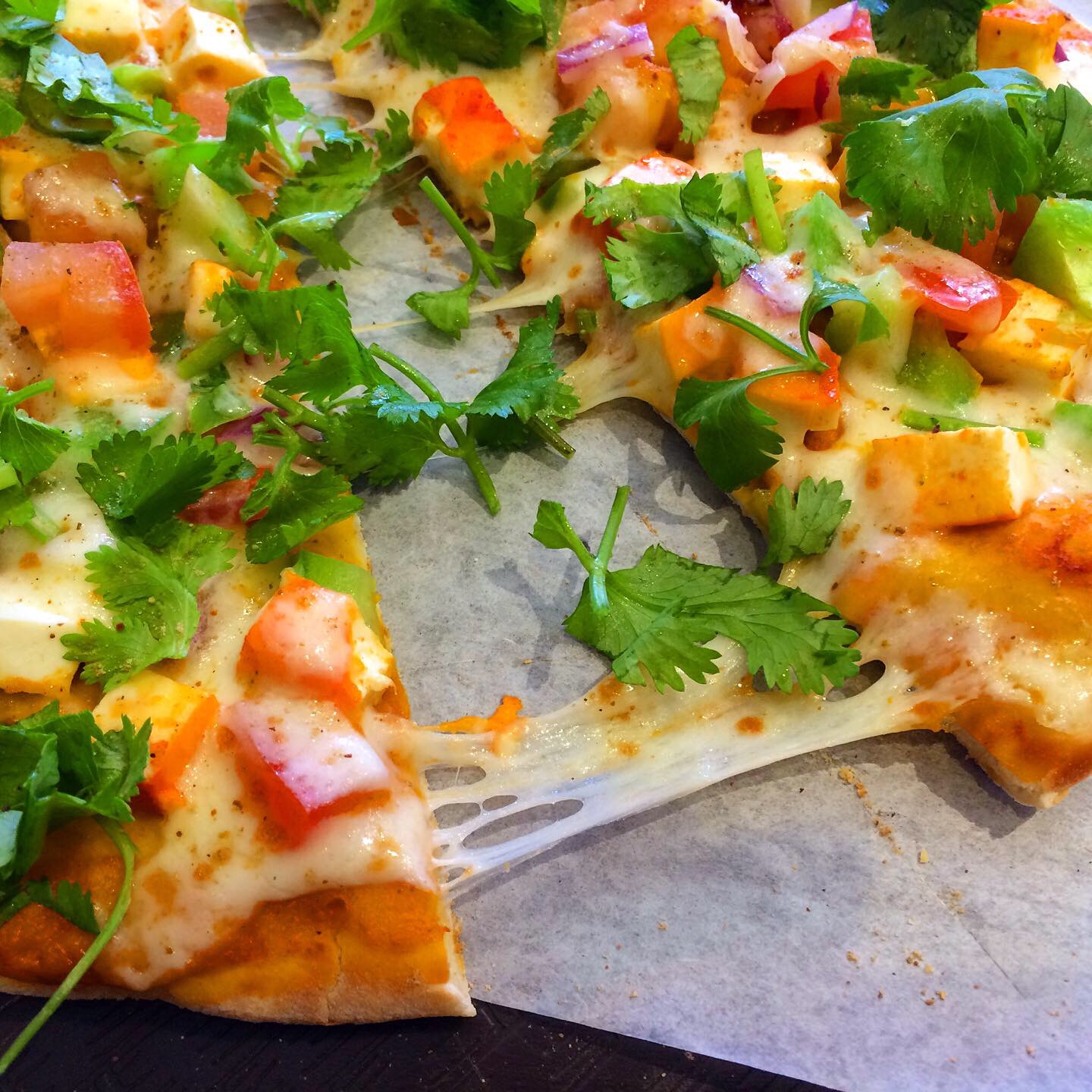
Cheese two ways: this is Paneer Tikka Naan Pizza which makes it non-pizza but I like it for what it is. (This is also a non-cheese pull because it’s horizontal rather than vertical; turn your screen sideways if that makes you happier.)
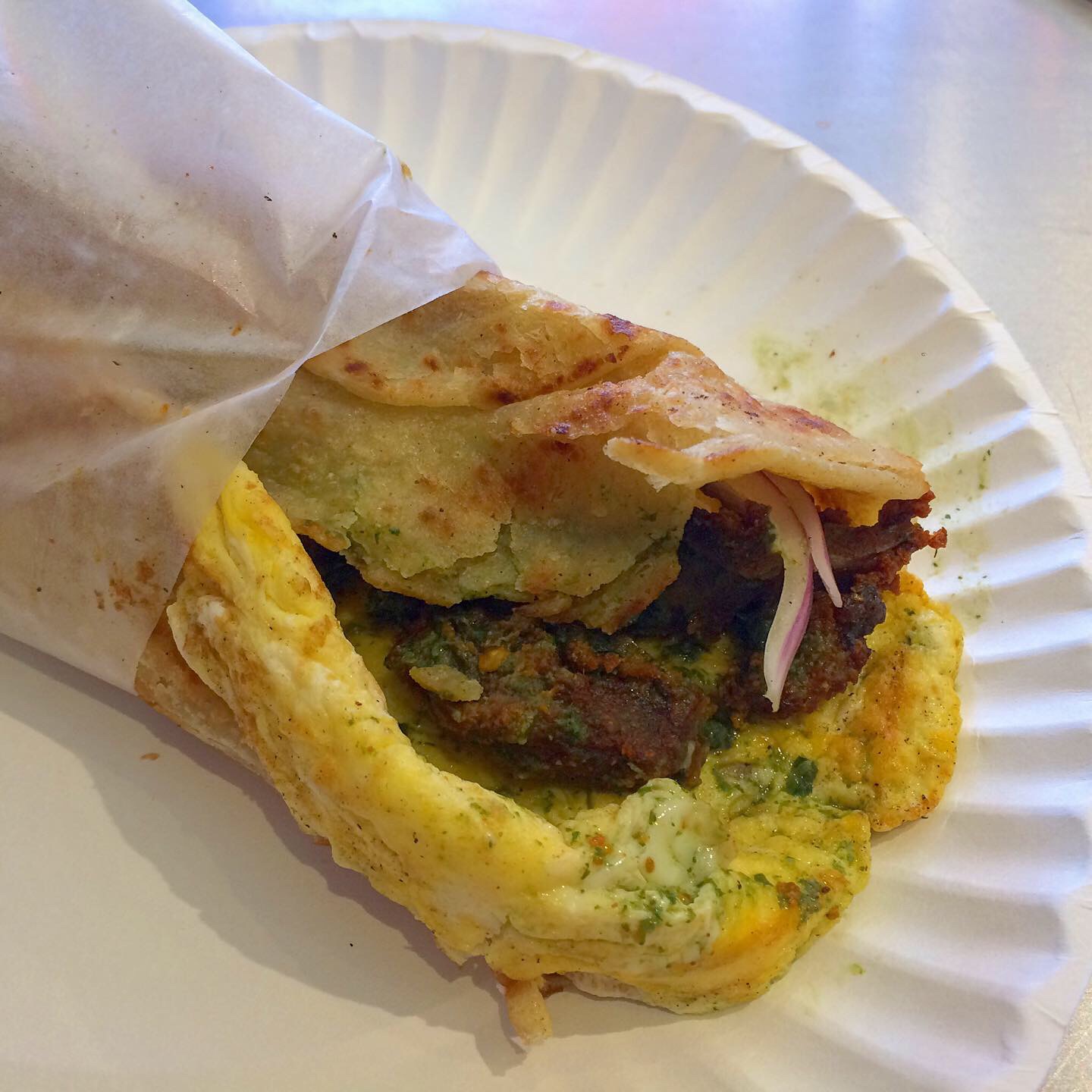
This is a kathi roll, Egg and Lamb Boti to be specific. The marinated, well-seasoned lamb (boti kebab) was a surprisingly good companion to the fried egg, the roti was supple and flavorful and it had a proper chew. Definitely good eats.
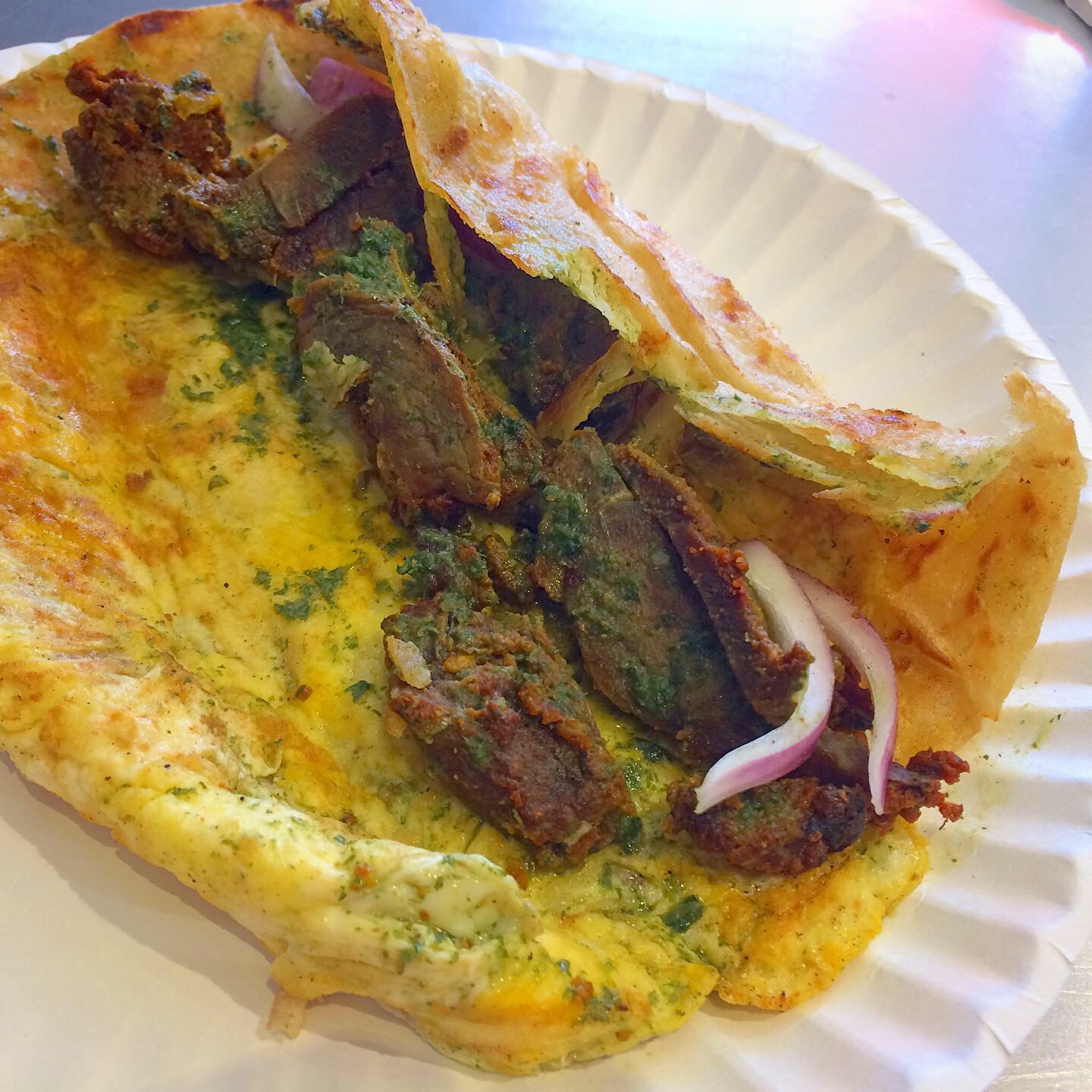
Deconstructed (or at least unfurled).
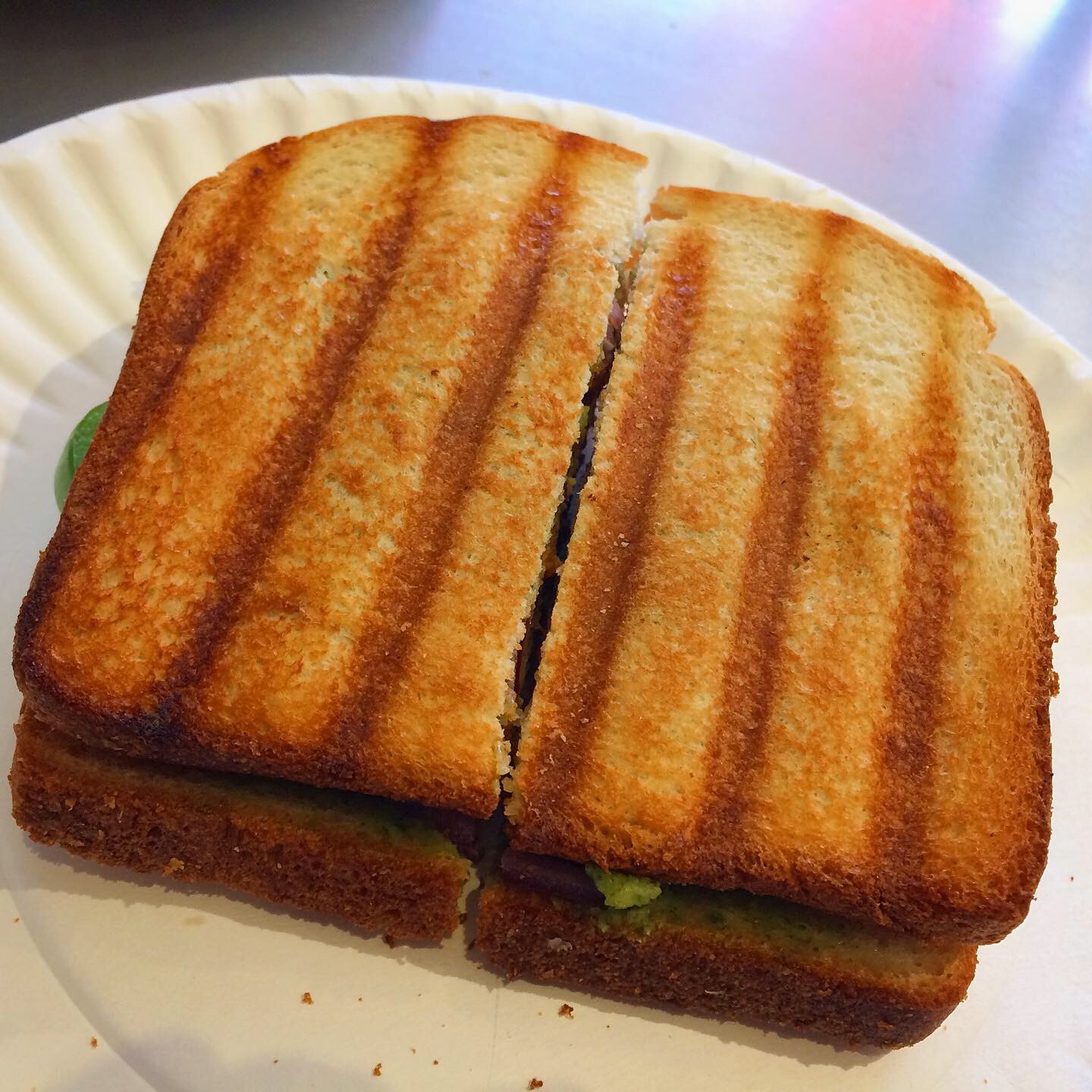
A grilled Bombay Sandwich (yes, that’s a thing), apparently always triple decker, features melted cheese, green pepper and red onion, coriander chutney, and in this case, slabs of chicken tikka. Much moister, and consequently better, than one I had elsewhere.
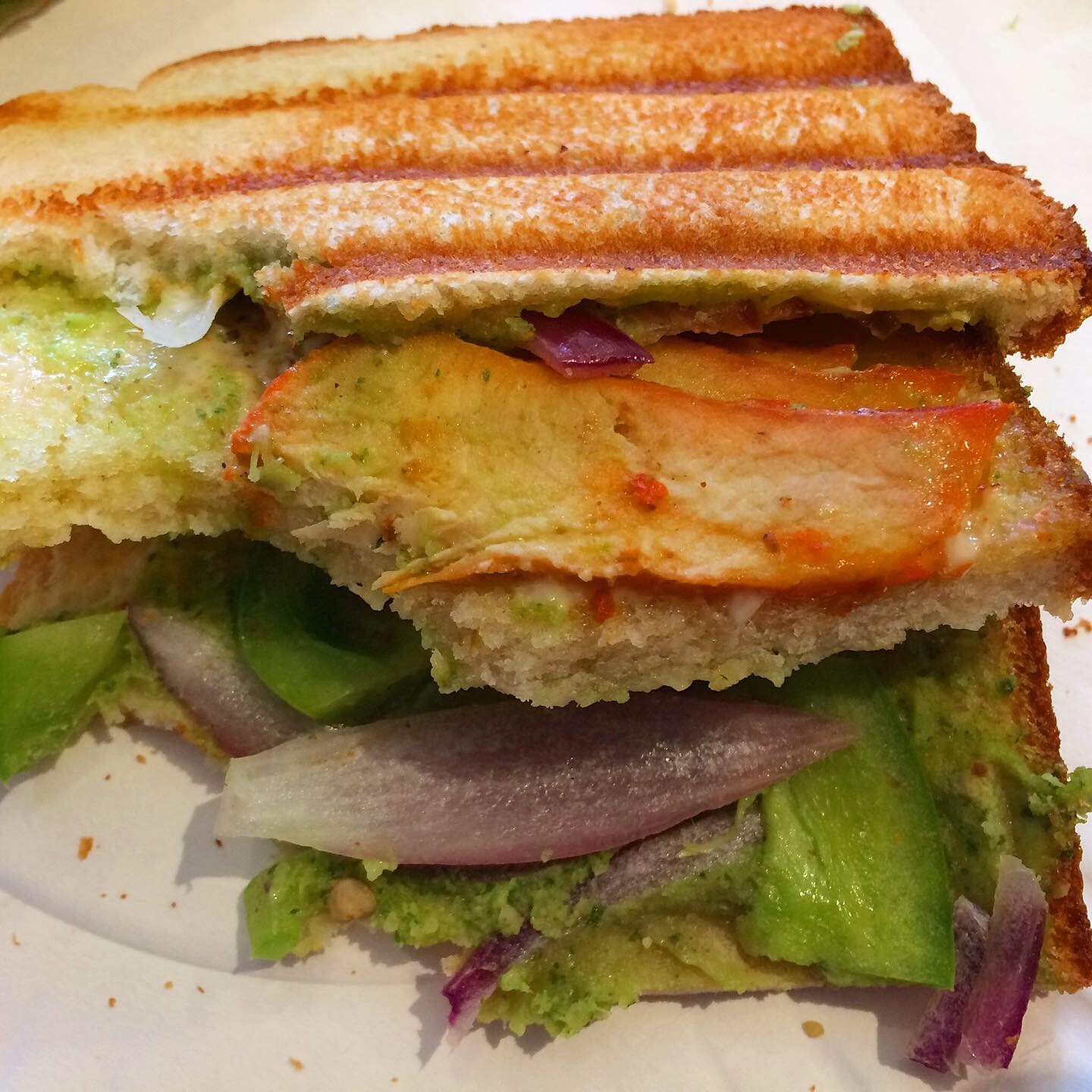
Deconstructed (or at least toppled).
Bombay Kitchen is located at 72-27 37th Ave in Jackson Heights, Queens. Best I could tell, it’s an extension of Rajbhog Sweets, so enjoy some kulfi or mithai for dessert while you’re there. Restored my faith in Indian street food!
(Click on any image to view it in high resolution.)
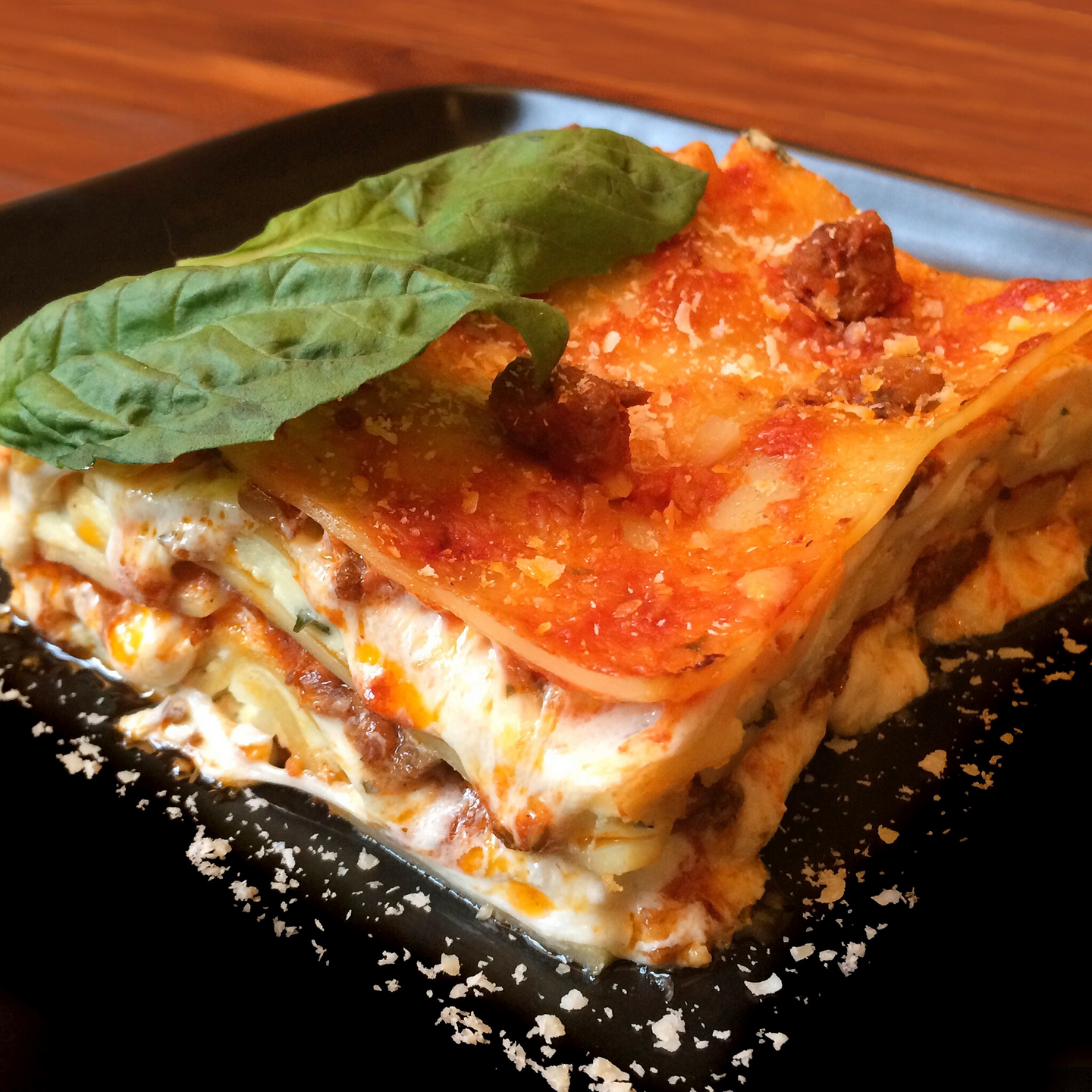
👨🍳 Cooking in the Time of COVID 👨🍳
These days, I find myself preparing a lot of comfort food and that invariably involves a plateful of starches, an extravagance of calories, and a mountain of regret on the bathroom scale the next morning. I try to use ingredients I have on hand so when I do make the now infrequent trip to my local supermarket, I grab just a few items to support some ad hoc recipes and then make a quick getaway. I had a finger of amazing Albanian suxhuk, a dry beef sausage, in the freezer; this particular link was extraordinarily spicy and I reckoned its best use would be as a component of some concoction rather than a straight up snack.
On my way to the market, visions of comfort foods (not the least of which was lasagna, TBH) danced in my head – although my goal was to supplement whatever I had at home frugally, not to open up a whole new can of worms. But that damned lasagna relentlessly persisted in invading my thoughts. Long story short: “just a few items” became several pounds of mozzarella, ricotta, and lasagna noodles, some fresh basil, and a jar of tomato sauce I particularly favor. I rationalized my obsessive compulsive behavior by averring that I could dice the bit of suxhuk and toss it into the sauce. And beyond that, I had some fennel seed at home in the spice rack that I could use to depatriate the suxhuk from Albania to Italy by adding it to the dish.
I’m pretty sure that’s not how the strategy is supposed to work.
Now, you probably think I’m going to end this tale with feelings of remorse because I consumed too much lasagna in the first sitting alone. But no. My first thoughts after the cooking frenzy subsided were that if I could squeeze even a few moments of joy from this blimpifying violation of my own guidelines, it was worth it.
The moral? It’s okay to be a little self-indulgent during the time of COVID. Reward yourself for being able to follow all the new shelter-in-place social-distancing rules with aplomb. Eat whatever it takes.
Stay sane. We’ll get through this together.
This was Saturday afternoon in Manhattan’s Chinatown. Saturday afternoon, people.
I’ve said it before. Businesses in Chinatown are struggling to make ends meet as potential customers’ trepidation over COVID-19 festers and deters patronage. Chinatown has been an ineffable source of delight, indulgence, and comfort to so many of us. Now is the time for all of us to do the right thing and show our gratitude and support for these businesses. If ever you’ve felt the desire to give back, this is your chance.
#supportchinatown #dineinchinatown #eatinchinatown #explorechinatown
Self-quarantining? I get it. So order in! #keepcalmandcarryout
(BTW, I can’t think of a better way to celebrate the conclusion of your confinement than a sumptuous dinner in our beloved Chinatown!)
All I’m asking is this: please don’t treat Chinatown restaurants any differently from the way you would treat any restaurant anywhere else. That’s the very definition of racial profiling.
#chinatown #chinatownnyc #chinatownnewyork #ilovechinatown
Over the next few days, I’ll post some photos of deliciousness from Chinatown’s restaurants, markets and street vendors taken during the past week. Stay tuned.
And thank you.

Note: This post was originally published on March 15, 2020 when the world was very different.